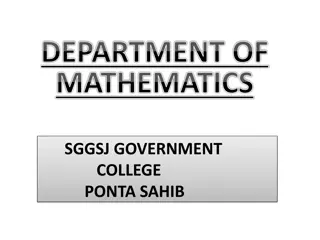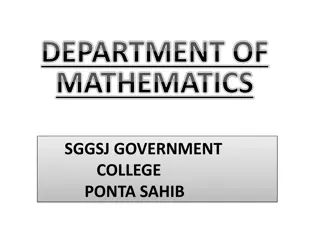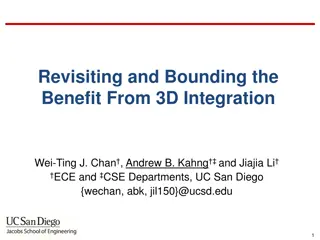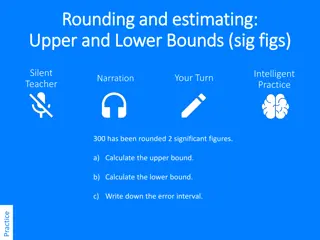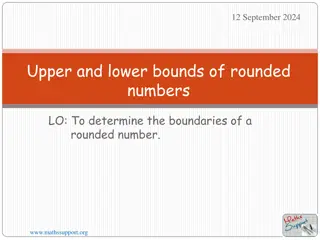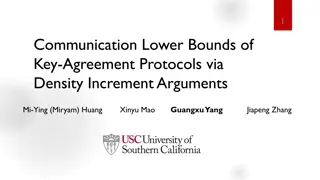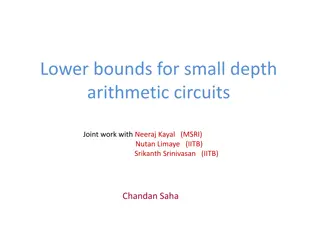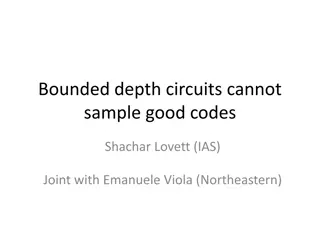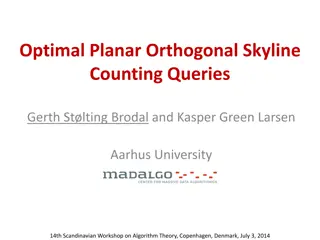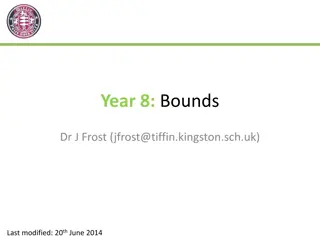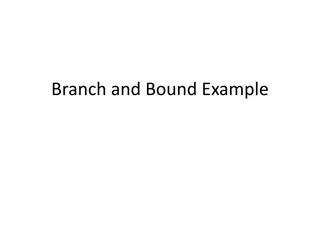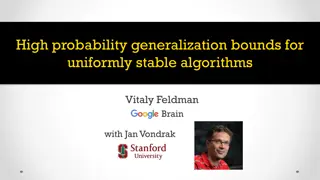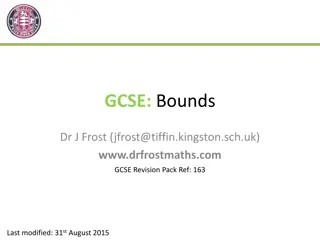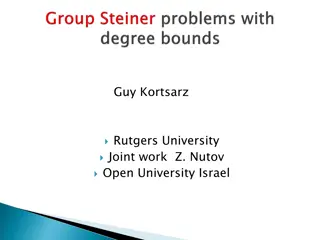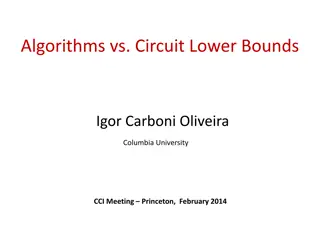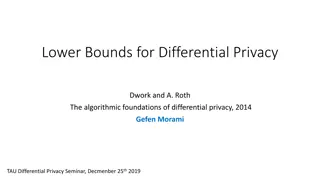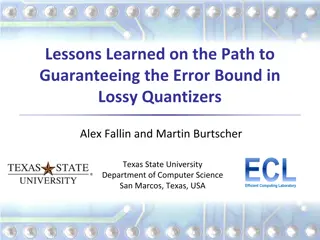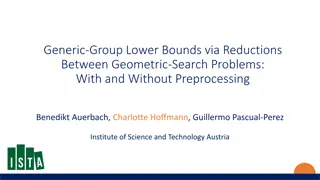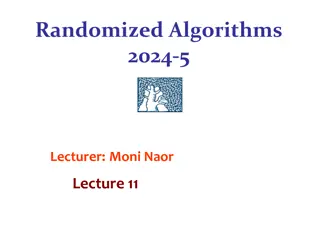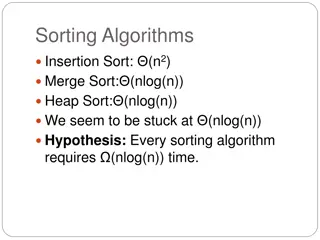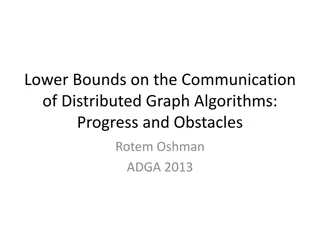Strong Average-Case Circuit Lower Bounds: A Brief Overview
Exploring the history and motivation behind the Circuit Lower Bounds Program focused on proving complexity class separations through non-trivial derandomization, with a primary emphasis on Strong Average-Case Lower Bounds. Ren and Chen delve into the pursuit to establish ?? ≠ ? since the 1980s.
1 views • 61 slides
Real Analysis: Intervals, Bounds, and Problem-solving
Explore the concepts of intervals and bounds in real analysis, including open and closed intervals, semi-closed intervals, least upper bound, and greatest lower bound. Learn how to solve problems based on intervals and bounded sets through detailed explanations and examples.
2 views • 11 slides
Real Analysis: Intervals, Bounds, and Problem Solving
Explore the world of real analysis through intervals, bounds, and problem-solving techniques. Learn about open intervals, closed intervals, semi-closed intervals, infinite intervals, least upper bound, greatest lower bound, and solve problems based on intervals and bounded sets. Enhance your underst
2 views • 11 slides
Rounding and Estimating: Upper and Lower Bounds Example
Explore how to determine upper and lower bounds after rounding numbers to the nearest 1000 or 100. Learn how to calculate the error intervals and practice your skills with provided examples. Gain a clear understanding of rounding to the nearest whole number and how to identify boundaries in estimati
2 views • 4 slides
Investigating Power and Area Reduction Bounds in 3D Integration
This study focuses on establishing upper bounds for power and area reduction in 3D Integrated Circuits (3DICs), specifically exploring the benefits of multi-tier 3DICs compared to lower-tier configurations. Previous works and evaluations on power and wirelength benefits are discussed, highlighting t
0 views • 24 slides
Upper and Lower Bounds in Rounding and Estimating
Learn how to calculate upper and lower bounds and error intervals when rounding numbers to significant figures. Practice rounding to different significant figures and apply the concept to various numerical values. Develop a solid grasp of estimation techniques with informative examples and visual ai
2 views • 5 slides
Tail Bounds in Probability for Computing
Tail bounds in probability theory play a crucial role in analyzing random variables and understanding the behavior of certain events. This content explores the concept of tail bounds, their importance through examples, and the derivation of upper bounds on tails. Markov's inequality is also discusse
0 views • 31 slides
Additive Combinatorics Approach to Log-Rank Conjecture in Communication Complexity
This research explores an additive combinatorics approach to the log-rank conjecture in communication complexity, addressing the maximum total bits sent on worst-case inputs and known bounds. It discusses the Polynomial Freiman-Ruzsa Conjecture and Approximate Duality, highlighting technical contrib
0 views • 9 slides
Upper and Lower Bounds in Measurements
Explore the concept of upper and lower bounds in measurements through examples involving rounding numbers and calculating boundaries for different units like centimeters, millimeters, and meters. Learn how to determine the range within which a rounded number falls for both discrete and continuous da
0 views • 9 slides
Upper and Lower Bounds in Mathematics
Exploring the concept of upper and lower bounds in mathematics, this content discusses how numbers are rounded to the nearest whole number and identifies the possible maximum and minimum values. It also provides examples and rules for finding upper and lower bounds, as well as practical applications
0 views • 6 slides
Lower Bounds in the Cell Probe Model
Exploring the concept of lower bounds for static data structures, this content delves into the tradeoffs between query time and space efficiency. It discusses the need for proving lower bounds, the model of data structures, and how CPUs access memory in computational devices. Kasper Green Larsen fro
1 views • 45 slides
Communication Lower Bounds of Key-Agreement Protocols
Key-agreement protocols play a vital role in secure communication between parties. This document explores lower bounds of key-agreement protocols through density increment arguments, idealization of symmetric primitives, Merkle puzzles, and the impact of communication bits between Alice and Bob. Var
1 views • 10 slides
Lower Bounds for Small Depth Arithmetic Circuits
This work explores lower bounds for small-depth arithmetic circuits, jointly conducted by researchers from MSRI, IITB, and experts in the field. They investigate the complexity of multivariate polynomials in arithmetic circuits, discussing circuit depth, size, and the quest for an explicit family of
0 views • 114 slides
Lower Bounds on Sampling Good Codes in Bounded-Depth Circuits
Bounded-depth circuits are proven unable to sample or approximate good codes effectively. This work delves into lower bounds, showcasing that bounded families of circuits face limitations in computing specific functions or sampling distributions. The example of Parity in AC0 circuits illustrates the
1 views • 21 slides
Advanced Techniques for Orthogonal Skyline Counting Queries
Advanced techniques for orthogonal skyline counting queries discuss optimal planar solutions, dividing and conquering for topmost point identification, efficient vertical slab counting, succinct data structures for prefix sums and range maxima, upper bounds on degree and multi-slab queries, as well
0 views • 11 slides
Measurement Bounds and Accuracy
Exploring the concepts of significant figures, bounds, accuracy, and ranges in measurement. From determining the smallest and largest possible lengths to finding lower and upper bounds based on accuracy, this content focuses on practical exercises and explanations to enhance understanding. Learn how
0 views • 6 slides
Propositional Proof Complexity and Lower Bounds
Studies focus on the intractability of propositional proof complexity, exploring the power of proof systems to verify tautologies. Discussion on known lower bounds and challenges in proving hardness of certain tautologies.
1 views • 23 slides
Lower bounds for approximate membership dynamic data structures
Information theory's powerful role in proving lower bounds for data structures. Discusses static and dynamic data structures, including the approximate set membership problem and Bloom filters. Explores how these structures represent subsets of a large universe with space-saving benefits.
0 views • 27 slides
Lower bounds for Unconditionally Secure MPC
Unconditionally secure MPC protocols like GMW and SPDZ are efficient but require significant interaction rounds. The challenge is to improve efficiency while maintaining security. Message complexity and round complexity play a crucial role in achieving this goal. Lower bounds help in understanding t
0 views • 15 slides
Range Avoidance
Delve into the realm of circuit lower bounds with Range Avoidance Part II. Uncover the complexities of Boolean functions, rigid matrices, and algorithmic methods for attaining stronger lower bounds in circuit theory. Explore intriguing connections between deterministic algorithms, non-trivial circui
0 views • 15 slides
Branch and Bound Example
The provided content details an example of using the Branch and Bound algorithm for optimal preemptive scheduling. It starts by establishing lower and upper bounds for different jobs and explores nodes to find the best preemptive schedule. The process involves iteratively determining the best schedu
0 views • 14 slides
High Probability Generalization Bounds for Stable Algorithms
This content delves into high probability generalization bounds for uniformly stable algorithms, showcasing insights on stability and generalization in machine learning. It covers topics such as stability in the face of individual examples, known bounds from previous studies, stochastic convex optim
0 views • 8 slides
Upper and Lower Motor Neurons
Upper motor neurons descend from the cerebral cortex or brainstem to influence lower motor neurons, while lower motor neurons innervate muscle fibers. Damage to upper motor neurons results in hyperreflexia and Babinski's sign, whereas lower motor neuron lesions lead to muscle weakness and decreased
0 views • 21 slides
Sorting Algorithms and Lower Bounds
Complexities and hypotheses surrounding sorting algorithms like Insertion Sort, Merge Sort, and Heap Sort. Delve into lower bounds and comparisons in the realm of sorting algorithms, with a focus on the number of comparisons required for efficient sorting. Discover new hypotheses and analyses on the
0 views • 8 slides
Rounding and Estimating Upper & Lower Bounds Example
Learn about calculating upper and lower bounds from rounded values with specific significant figures. Practice rounding techniques and determining error intervals. Explore worked examples and value rounding to enhance your understanding.
0 views • 5 slides
GCSE Bounds Revision Pack
GCSE bounds concepts with exercises on significant figures, lower and upper bounds, and calculating areas within given accuracy levels. Understand the importance of considering bounds in mathematical calculations for precise results.
0 views • 9 slides
Group Steiner Tree Problem: Approximation Methods and Degree Bounds
The Group Steiner Tree Problem involves finding a tree rooted at a central vertex that connects transistors located at different ports in a VLSI circuit. Various approximation methods and degree bounds have been explored, with a focus on low degrees for efficient layout and routing. Known approximat
0 views • 21 slides
New Circuit Lower Bounds and Complexity Theory Insights
Explore new circuit lower bounds and complexity theory insights, including motivation, background, new results, and known facts. Discover the significance of exponential circuit lower bounds and the challenges within complexity theory.
0 views • 43 slides
Understanding Circuit Lower Bounds and Algorithm Techniques
Explore the intersection of algorithms and circuit lower bounds in this informative talk, covering topics like explicit functions, compression, and nontrivial proofs for computational problems. Discover the significance of learning satisfiability and techniques for deterministic, nondeterministic, a
0 views • 32 slides
Matrix Rigidity Upper Bounds Tutorial by Josh Alman
Explore the concept of matrix rigidity upper bounds and techniques for showing matrices are not rigid. Learn about diagonalization, the polynomial method, and results like Walsh-Hadamard transform. Discover how to identify non-rigid matrices and their products. Dive into the world of matrix rigidity
0 views • 22 slides
Understanding Hardness Magnification in Lower Bound Frontiers
Explore the concept of Hardness Magnification (HM) in computational complexity theory, where weak lower bounds lead to strong lower bounds. Discover recent results and examples showcasing the implications of HM in advancing lower bound research.
0 views • 24 slides
Exploring Lower Bounds in Computer Science
Delve into the realm of computer science lower bounds, focusing on topics such as P vs. NP, Boolean satisfiability, algorithm complexities, and the significance of best algorithms in problem-solving. Discover the challenging questions and implications related to solving complex computational problem
0 views • 61 slides
Differential Privacy Lower Bounds & Privacy Preserving Mechanisms
Explore the concept of lower bounds in differential privacy, how accurate responses must be to preserve privacy, the definition of privacy mechanisms, reconstruction attacks, and theorems explaining privacy preservation. Understand the impact of noise addition on data privacy.
0 views • 41 slides
Insights on Achieving Error Bounds in Lossy Quantizers
Explore the journey towards ensuring error bounds in lossy quantizers, crucial for handling vast scientific data in HPC settings. Learn about the challenges of lossy compression, support for heterogeneous systems, and a cutting-edge LC Framework tool for automatic compressor synthesis. Dive into how
0 views • 26 slides
Lower Bounds and Reductions in Geometric Search Problems
Explore lower bounds and reductions in geometric search problems, featuring the generic group model, GGM hardness, and transfer bounds via algebraic group models. Learn about extensions to preprocessing bounds and the technical overview of these concepts for problem-solving.
0 views • 13 slides
Price Lower Bounds and Option Valuations in Finance
Explore lower bounds for pricing call and put options on non-dividend-paying stocks in various scenarios along with determining implied risk-free rates based on European option prices. Delve into option valuation concepts and calculations for different stock prices, strike prices, and interest rates
0 views • 5 slides
Randomized Algorithms 2024-5: Guessing Cards and Communication Complexity Bounds
Explore the concepts of guessing cards, simultaneous communication complexity bounds, and efficient encoding techniques in randomized algorithms. Dive into strategies for memory-based card guessing and optimal memory allocation for maximizing correct guesses. Discover the underlying principles of si
0 views • 48 slides
Understanding Tail Bounds and Confidence Intervals for Random Variables
Explore the concept of tail bounds in probability theory, along with confidence intervals for random variables. Learn about Markov's Inequality and how it provides upper bounds for probabilities, illustrated with examples involving dice rolls and online advertising.
0 views • 22 slides
Understanding Sorting Algorithms and Lower Bounds
Explore the concept of sorting algorithms, lower bounds, and comparison-based sorting, discussing the time complexity and required comparisons in different scenarios. Dive into hypotheses, proving lower bounds, and average case analysis to gain insights into the efficiency of various sorting methods
0 views • 8 slides
Progress and Obstacles in Distributed Graph Algorithms
Explore the lower bounds on the communication of distributed graph algorithms, including techniques for proving lower bounds in different network models and the application of 2-party communication complexity. Discover examples like the DISJOINTNESS problem and new challenges such as the PARTITION p
0 views • 37 slides

